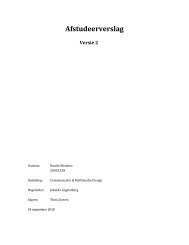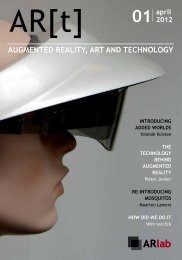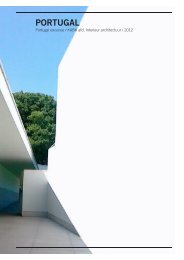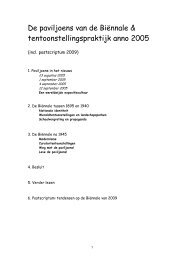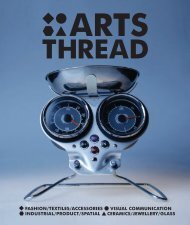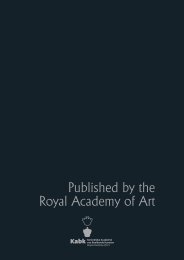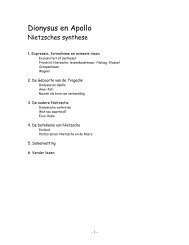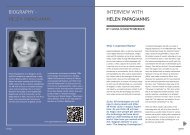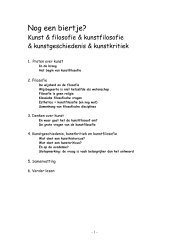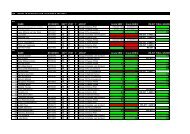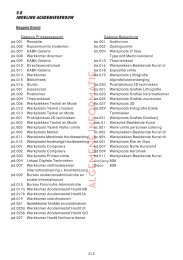SWITZERLAND - Kabk
SWITZERLAND - Kabk
SWITZERLAND - Kabk
You also want an ePaper? Increase the reach of your titles
YUMPU automatically turns print PDFs into web optimized ePapers that Google loves.
<strong>SWITZERLAND</strong>Switzerland Excursion / KABK Interior Architecture / 2013
Switzerland Excursion / KABK Interior Architecture / 2013Switzerland Excursion / KABK Interior Architecture / 2013INTRODUCTIONMarch 2013Switzerland’s image has always been closely linked to unspoilt nature andefficient service industries. It is, therefore, no wonder that it has attracted morepeople in search of steep mountainsides dotted with wooden chalets and grazingcows than seekers of avant-garde architecture. And yet, the last two decadeshave seen a hitherto unparalleled production of innovative buildings. The qualityof recent architecture in Switzerland, in combination with the phenomenonof cultural consumerism, has pushed many projects to the centre of popularattention: Peter Zumthor’s thermal bath in Vals, Vitra’s architectural themepark at Weil am Rhein just over the border in Germany, Mario Botta’s TinguelyMuseum in Basel and Jean Nouvel’s Kultur- und Kongresshaus in Lucerne, toname only a few. Every year these sites attract thousands of visitors in search ofan architectural experience. In the 1990’s, Swiss architects such as Herzog & deMeuron and Zumthor have come to be regarded as among the main proponentsof the international avant-garde as they address some of the most hotly debatedissues in contemporary architecture.The Minimalist boxFrom the outside, Swiss architecture, and in particular the newer buildings in theGerman-speaking part of the country, appear simple and sober. Its simplicity is,however, also its enigma. Firmly placed into the ground without base and devoidof any loud spatial contraptions, this architecture avoids spectacular semioticform-giving. A discreet immediacy of materials, a firm belief in technology anda recognition of the banal are much more central than artifice, collage or evenirony. Articulating neither front nor back, nor referring to the human scale,the underlying focus often lies on the material. This self-referentiality can beproblematic when the relationship to the context is too subtle or when merereduction is regarded as an architectural solution in itself. The Swiss affinity tothe box is seemingly grounded in an embarrassment of riches. This finds itsroots in Calvinist puritanism and the heritage of a largely agrarian life. Wealth inthe country is rarely displayed outwardly; rather, it manifests itself in a discreetunderstatement cherishing quality and precision. Whereas ‘simple’ often carriesthe connotation of ‘cheap’ elsewhere, in Switzerland ‘simple’ is often understoodas being very expensive. At first glance the labels ‘new simplicity’ or ‘newminimalism’ are easy and convenient to use, satisfying a need to group andclassify. This classification is, however, much contested by insiders who fiercelyTherme Vals 1545
Switzerland Excursion / KABK Interior Architecture / 2013Switzerland Excursion / KABK Interior Architecture / 2013denounce the oversimplification of a seeming uniformity: some focus on tectonicand structural clarity, others pursue new ways in the application of prefabricatedcomponents . Zumthor concentrates on craftsmanship and the atmosphericqualities of natural materials. Herzog & de Meuron go a step further even, andquestion materiality itself by continuously thematising perceptions of the surface.Groomed nature and civilised engineeringNature is Switzerland’s most impressive feature, but besides the untamed andharsh mountain peaks of the Alps, Swiss nature is anything but natural: virtuallyevery patch is cultivated and perfectly groomed. Such exceptional care is alsodevoted to a building culture strongly rooted in regional traditions. It reinforcesthe widespread image of a neat and tidy land - city centres and mountain villagesalike. The remoteness of certain areas has contributed to this rich variety ofdistinct regional traditions, reflected in the formal articulation, materiality andconstruction tech niques used - such as the wooden chalet in the Valais, thestately Bernese farmhouse, or the stout, white houses in the Engadin. Whatendows even the remotest area with a sense of contemporaneity is the way inwhich all of Switzerland is bound into a tightly controlled infrastructure, withineasy and comfortable reach by means of roads, trains, postal buses or chairlifts.This accessibility and efficiency is the result of a long history of sophisticatedcivil engineering. The motorways, bridges, hydroelectric dams, tunnels and theodd military fortification than their colleagues in other countries, many architectsin Switzerland have over time become an integral part of the landscape. Theinfluence on architecture of engineers such as Robert Maillart or Christian Mennis undisputed, and there have been several fruitful collaborations betweenarchitects and civil engineers in recent years, such as the Sunniberg bridge thewooden bridge in Nesslau or the Transjurane motorway.Have a good trip, enjoy and experience the country with his overwhelming natureand beautiful architecture.Ramin Visch en Jeroen Musch.Vitra Haus 2667
Switzerland Excursion / KABK Interior Architecture / 2013Switzerland Excursion / KABK Interior Architecture / 2013DAY 1 (Zurich)Sunday 24th April08.20 Arrival Zurich HB(Train leaves 23th of March from Utrecht CS at 20:59)08.37 tram 7 to Youth Hostel Zurich09.00 Inchecken Youth Hostel Zurich(no Breakfast)09:30 Start architectural walk Zurich:- Museum Rietberg (Design: Alfred Grazioli&Adolf Krischanitz) 1- Bahnhof Enge (Design: Otto und Werner Pfister) 2- Haus Konstruktiv (Design: Herman Herte) 3- Construction of Tamedia office building (Design: Shigeru Ban)- Extension of kino Xenix (Design: Frei+ Saarinen Architecten) 4- Aussersihl Community Centre (Design: EM2N) 512:30 Lunch in Les Halles13:30 Start guided tour by architect Dominique Lorenz:- Freitag Flagship Store (Design: A. Spillmann&H. Echsle) 6- Frau Gerolds Garten 7- Prime Tower (Design: Gigon/Guyer Architekten) 8- Im Viadukt (Design: EM2N) 9- Schiffbau (Design: Ortner & Ortner) 10- Toni Areal (Design: EM2N) 1116:00 - Visit Kunsthalle Zurich (Design: Gigon/Guyer Architekten) 1217:00 - Museum fue Gestaltung (Design: Adolf Steger, Karl Egender) 13- Europaallee (Design: Various archietcts)- Stadelhofen Station (Design: Santiago Calatrava) 1418:30 FreeTips- Thermalbad & Spa Zürich- Riffraff Bar- Restaurant Rosso- HelsinkiFreitag Flagship Store 689
Switzerland Excursion / KABK Interior Architecture / 2013Switzerland Excursion / KABK Interior Architecture / 2013DAY 2 (Vals)Monday 25th March06.30 Breakfast07:35 Tram 7(Halte Morgental) to Zurich HB08:07 Train to Chur HB station09:22 Walk to hostel JBN, Welschdörfli 19, Chur(34 minutes!)09:56 Train to Ilanz and bus to Vals11:09 Arrival Vals11.30 uur Visit Therme Vals (Design: Peter Zumthor) 15- every half hour 1 group of 6 peopleTake a walk and visit the village of Vals and the following projects- Villa Vals (not open for public)(Design: SEARCH, Christiaan Müller Architects) 16- Annalisa Zumthor House (not open for public)(Design: Peter Zumthor) 17- Pedestrian bridge (Design: Jürg Conzett) 1816:36 Bus to Ilanz and train to Chur18:11 Arrival Chur18:30 FreeTips- Giger Bar · Comercialstrasse 23 · 7007 Chur(must see)- Selig Tanzbar · Welschdörfli 19 · 7002 Chur- Schall und Rauch · Welschdörfli 11 · 7000 ChurTherme Vals 151011
Switzerland Excursion / KABK Interior Architecture / 2013Switzerland Excursion / KABK Interior Architecture / 2013DAY 3 (Chur)Tuesday 26th March07:30 Breakfast08:30 Start architectural walk Chur:- Shelters for Roman Archaeological Site 19(Design: Peter Zumthor)- Public Staircase (Design: Esch Sintzel) 20- Eentrance of the Graubünden Parliament 21(Design: Valerio Olgiati)- Holy Cross Church in Chur (Design: Walter Förderer) 22- Furstenwald Cemetery (Design: Urs Zinsli) 2313:00 Lunch14:00 Old city tour Chur16:09 Train to Basel19:00 Arrival at Youth Hostel Basel19:30 FreeTips- Bar zum Kuss- Volkshaus Brasserie & Bar (Design: Herzog & de Meuron)- Bar RougePublic Staircase 201213
Switzerland Excursion / KABK Interior Architecture / 2013Switzerland Excursion / KABK Interior Architecture / 2013DAY 4 (Basel)Wednesday 27th March07:30 Breakfast10:30 Tram and Bus to Dornach11:30 Exploring gardens and building of the Goetheanum 2412:30 Guided tour interior Goetheanum (Design: Rudolf Steiner)14:00 Lunch15:00 Tram and Bus to Tingeley Museum16:00 Visit Tingeley Museum (Design: Mario Botta) 2517:30 Walk to Basel Badischer Bahnhof17:45 Basel Badischer Bahnhof (Design: Karl Joseph Berckmüller)18:00 FreeTips- Bar zum Kuss- Volkshaus Brasserie & Bar (Design: Herzog & de Meuron)- Bar RougeGoetheanum 241415
Switzerland Excursion / KABK Interior Architecture / 2013Switzerland Excursion / KABK Interior Architecture / 2013DAY 5 (Basel)Thursday 28th March07:30 Breakfast09:01 Tram and bus to Weil am Rhein Vitra10:00 Start architectural tour Vitra Campus Site: 26- Vitra House(Design: Herzog & de Meuron)- Factory Buildings from Sanaa, Alvaro Siza, Frank Gehry- Bus Stop(Design: Jasper Morrison)- Fire Station(Design: Zaha Hadid)- Conference Pavilion(Design: Tadao Ando)- Vitra Design Museum(Design: Frank Gehry)- Dome(Design: Richard Buckminster Fuller)- Petrol Station(Design: Jean Prouvé)12:00 Visit Vitra Design Museum (Design: Frank Gehry) 26Current exhibition: Louis Kahn, The Power of Architecture13:00 Lunch14:00 Tram and bus to Museum der Kulturen15:30 Museum der Kulturen (Design: Herzog & de Meuron) 2716:00 Tram to Schaulager16:30 Visit Schaulager (Design: Herzog & de Meuron) 2818:00 Architectural walk:- Signal Box (Design: Herzog & de Meuron) 29- Railway Engine Depot (Design: Herzog & de Meuron)- Apartmentbuilding (Design: Herzog & de Meuron) 3019:00 FreeTips- Bar zum Kuss- Volkshaus Brasserie & Bar (Design: Herzog & de Meuron)- Bar RougeVitra House 261617
Switzerland Excursion / KABK Interior Architecture / 2013Switzerland Excursion / KABK Interior Architecture / 2013DAY 6 (Basel)Friday 29th March07:30 Breakfast08:30 Free11:30 Tram to Basel HB11.45 Arrival at Basel HB12.20 Departure train to Utrecht CS20:00 Arrival at Utrecht CSInterior Zaha Hadid Fire Station 261819
Switzerland Excursion / KABK Interior Architecture / 2013Switzerland Excursion / KABK Interior Architecture / 2013MUSEUM RIETBERG1DesignAlfred Gradmann(1950) & Alfred Grazioli and Adolf Krischanitz(2007)Factslocation Zurichfunction Museumbuild 1950 & 2007InformationThe Rietberg Museum is a museum in Zürich, Switzerland, displaying Asian,African, American and Oceanian art. It is the only art museum of non-Europeancultures in Switzerland, the third-largest museum in Zürich, and the largest tobe run by the city itself. In 2007 it received approximately 157,000 visitors. TheRietberg Museum is situated in the 69,000 m 2 Rieterpark in central Zürich, andconsists of several historic buildings: the Wesendonck Villa, the Remise, theRieter Park-Villa, and the Schönberg Villa.In 2007 a new building designed by Alfred Grazioli and Adolf Krischanitz wasopened – the addition of this largely subterranean building, known as “Smaragd”,more than doubled the museum’s exhibition space. In the early 1940s the cityof Zürich purchased the Rieterpark and the Wesendonck Villa. In 1949 theWesendonck Villa was selected, by referendum, to be rebuilt into a museum forthe Baron Eduard von der Heydt’s art collection, which he had donated to the cityin 1945. This was carried out in 1951-52 under the architect Alfred Gradmann.The Rietberg Museum was opened on 24 May 1952. Until 1956 the director wasJohannes Itten, the Swiss expressionist painter.In 1976 the city acquired the Schönberg Villa, which had been threatened withdemolition, and opened it in 1978 as an extension of the museum. Today the Villais also home to an extensive non-lending library administrated by the museum.The presidential department of the city of Zürich operates the Rietberg Museum.In 2007 it employed around 100 people. About half of the funding comes fromthe city, while the other half is raised through revenue, sponsoring and charity.Additions to the collection come mostly from donations.The museum established an in-house press shortly after its founding in 1952.2021
Switzerland Excursion / KABK Interior Architecture / 2013Switzerland Excursion / KABK Interior Architecture / 2013BAHNHOF ENGE2DesignOtto and Werner PfisterFactslocation Zurichfunction Railway stationbuild 1925InformationThe history of the Train Station Zurich Enge (Bahnhof Ende) dates back to 1875,although the current building was constructed between 1925 and 1927.The architects of this monumental granite building were thebrothers Otto and Werner Pfister. The building consists of twoarcades and a well-worth seeing inner courtyard with an atrium.2223
Switzerland Excursion / KABK Interior Architecture / 2013Switzerland Excursion / KABK Interior Architecture / 2013HAUS KONSTRUKTIV3DesignHerman HerteFactslocation Zurichfunction Art museumbuild 1929InformationThe powerful corpus and prominent tower of the ewz-Unterwerks (City of ZurichElectrical Substation) Selnau are a city landmark by the river Sihl. The buildingis of cultural and historical importance, having served the City of Zurich as aconverter station and having provided the city with its electricity for approximately100 years. The oldest part of the building dates back to 1898. In 1929/32,it was converted by the city planner of that time and well-known architect,Hermann Herter into an integrated construction in the style of new architecture.Technological progress rendered the ewz-Unterwerk Selnau superfluous and withthe exception of the rectifier and the substation in the basement, it was closeddown in 1998. The City of Zurich classified this unique testimony to industrialarchitecture as an historical monument, redeveloped it and converted it into acultural centre.The conversion was carried out by the Zurich Architects Meier + SteinauerPartner AG in 2000/01, who were contracted by the Foundation for Constructiveand Concrete Art and it was made possible by the generous support of the publicauthorities (federal, cantonal and city), business and industry, as well as bynumerous private donations.2425
Switzerland Excursion / KABK Interior Architecture / 2013Switzerland Excursion / KABK Interior Architecture / 2013EXTENSION OF KINO XENIX4DesignSchool Department of Zürich & Frei+ Saarinen ArchitectenFactslocation Zurichfunction classroom & cinemabuild 1904 & 1984InformationIn 1904, the School Department of Zürich erected several temporary woodenpavilions in order to respond to the rising demand for classrooms.In 1984, one of these “temporary” - and partially abandoned - structures wasconquered by a young group of film enthusiasts who had the idea to setup analternative cinema. The concept of “Kino Xenix” was as simple as it was successful:A unique film selection (every month a new program containing up to 30 differentmovies with a conceptual relation) plus a bar that generated the necessaryturnover to finance the cinema. The former schoolrooms were converted into anauditorium; the three meter wide corridor into a bar.Later, Xenix became a company. In order to run the bar on a professional level,additional sheds for storage and cooling beverages were added to the building.Since none of the structures conformed to building laws, a final solution hadto be found. The crew did not want to leave the prime location in the centre ofZurich, so the 100-year-old wooden building was expanded according to the law,incorporating all necessary additional spaces, such as a cooling room, restrooms,a small kitchen, and storage space. Since the bar was frequently overcrowded, ittoo was expanded. In developing ideas on expansion, it became clear that the opportunityshould be taken to rethink and redesign the entire interior space. Withthis realization, the list of desires grew: more seats for spectators, a better view ofthe screen, a larger lobby for the cinema.2627
Switzerland Excursion / KABK Interior Architecture / 2013Switzerland Excursion / KABK Interior Architecture / 2013AUSSERSIHL COMMUNITYCENTRE5DesignEM2N ArchitectsFactslocationfunctionbuildZurichCommunity Centre2000 First project, 2002 Second ProjectInformationThis project was won in competition in 1999. The site is a historic memorial park,on the western side of the city centre - a sensitive location. The architects decidedto break with convention for a community centre, and build vertically, rather thanhorizontally. The initial proposal was for a six-store, angular tower nestling bysome trees on the eastern side of the site. After completing the design, the budgetwas slashed, and the design team was send back to the drawing board.The revised scheme is still in the form of a tower, but only four stores, including abasement and kidney-shaped in plan. The structure is formed of lime brick wallsand concrete floor slabs. It is clad in timber boards, stained dark green, to helpthe building blend in with its surroundings. By contrast, the interior is paintedin many different and bright colors. The ground floor contains a café, which ispopular with the locals out enjoying the park.2829
Switzerland Excursion / KABK Interior Architecture / 2013Switzerland Excursion / KABK Interior Architecture / 2013FREITAG FLAGSHIP STORE6DesignMarkus and Daniel FreitagFactslocation Zürichfunction Storebuild 1993InformatieSeventeen freight containers piled one on top of the other rise up into thesky 85 feet above the ground in the trendy Zürich West district.This unusual shop houses 1600 uniquely designed bags throughout fourlevels – the largest selection of ‘Individual Recycled Freewaybags’ in theworld in all colors and sizes.The Freitag brothers produce over 120,000 bags and accessories everyyear from recycled materials taken from the streets - used, exhauststainedtruck tarpaulins, the inner tubes of bicycle tires, old safety beltsand air-bags. All this is transformed into absolutely unique items - trendy,functional, waterproof, robust. In fact, it was Zürich-West itself thatinspired the Freitag brothers to make bags out of truck tarpaulins in thefirst place, thanks to the colorful trucks that trundle through the districton the transit route every day.From the roof of the recycling skyscraper, one can enjoy a bird’s eyeview of the former industrial district. Far below at ground level, new life ispulsating behind former factory walls.3031
Switzerland Excursion / KABK Interior Architecture / 2013Switzerland Excursion / KABK Interior Architecture / 2013Frau Gerolds Garten7DesignFrau GeroldFactslocation Zurichfunction Open air restaurant, bar, shopping areabuild 2009InformationThis open air restaurant, bar, shopping area and urban gardening project offers agreen haven in industrial Zurich West. Frau Gerolds Garten has already becomea popular addition to this lively area marked for urban regeneration, neighboringRestaurant Rosso among others.While the bar and restaurant have gone into hibernation until next month, thecontainers housing fashion labels and art studios will keep their doors openduring the colder season. Check the website for more details.As befits the area, Frau Gerolds Garten ticks all the right boxes when it comesto on-trend urban development: The people behind it have a great track recordin running popular bars. The food is partly grown on site, with the rest beingorganic and locally sourced. There is a community thread running through, withlocals being invited to grow their own veg on site. Crucially, Frau Gerolds Garten’sdays are already numbered: In around five years’ time, plans are for Zurich’snew convention centre to be built here. The garden has been built with this inmind: its container construction and veg beds will then be packed up and movedelsewhere.One way or another, Frau Gerolds Garten is here to stay.3233
Switzerland Excursion / KABK Interior Architecture / 2013Switzerland Excursion / KABK Interior Architecture / 2013PRIME TOWER8DesignGigon / Guyer architektenFactslocation Zurichfunction commercial space, officebuild 2011InformatieThe Prime Tower Zurich is an architecturally and conceptuallydesigned building complex that combines history and modernity in aninteresting way. It is the tallest skyscraper in Switzerland at an altitudeof 126 meters (413 ft). The building is located near the Hardbrückestation. A seldom used freight railway is a few meters away fromthe building. The tower replaces an industrial facility that has beendemolished. According to the developers, the tower construction,which took 15 years to plan and execute, was a financial success,with its valuation based on lease rates exceeding the constructioncosts of CHF 110 million. The tower and the two accompanyingbuildings Cubus and Diagonal, are mainly used as office. The complexconsists of four buildings, connecting walkways and a park-likeoutdoor landscape. Inside the house, companies have moved intotheir premises. Public areas such as restaurants and shops, a fitnesscenter, galleries and childcare facility to the site a lively neighborhood.3435
Switzerland Excursion / KABK Interior Architecture / 2013Switzerland Excursion / KABK Interior Architecture / 2013IM VIADUKT9DesignEM2N architektenFactslocation Zurichfunction commercial space, market, mixed-use developmentbuild 2010InformationUp until now it separated the ‘old’ and the ‘new’ District 5. Now the railway viaductwill be the element linking the two. This monument to early industrial timesis to become the site of an unusual shopping and commercial district with Zurich’sfirst ever covered market. Direct, simple, reduced to a minimum – this wasthe EM2N architects’ motto. The rough stonewalls can still be seen on the interiorof the rooms, preserving the rugged charm of the construction and accentuatingthe uniqueness of the surroundings. This fits in with the PWG Foundation’s intentionof charging low rents for the arches. The foundation envisaged creating a hubof enjoyment, aesthetics and creativity from which both the city and the tenantscould profit. The area enjoys a broad, eclectic mix for different sections of thepopulation. IM VIADUKT is a melting pot of the individual strengths of extraordinaryand creative businesses.3637
Switzerland Excursion / KABK Interior Architecture / 2013Switzerland Excursion / KABK Interior Architecture / 2013SCHIFFBAU10DesignOrtner & OrtnerFactslocation Zurichfunction auditorium, music theatre, restaurantbuild 2001InformationWorkshops, studio, rehearsal stages and other facilities of the ZurichSchauspielhaus (theatre) previously scattered across different sites aregathered together here to form a centre on the former Sulzer-Escher-Wyss industrial site (shipyard). The Schiffbauhalle (shipbuilding shed),which is under a preservation order, was adapted to serve as foyer andhall theatre. A jazz forum and restaurant are also located here. Directlyconnected with it is the new building organised around a courtyard, whichhouses all the workshops and offices of the Schauspielhaus and, at thetop, a ring of two-storey privately owned apartments arranged aroundan internal courtyard that can also used be used as an open-air theatre.3839
Switzerland Excursion / KABK Interior Architecture / 2013Switzerland Excursion / KABK Interior Architecture / 2013TONI AREAL11DesignEM2N architektenFactslocation Zurichfunction Zürich University of Applied Sciencesbuild 1914InformationThe Toni-Areal is a crucial part of the plan to breathe new life into Zürich West.The building was formerly a milk processing facility, and the new design byarchitecture firm EM2N features spaces for cultural events, as well as the ZürichUniversity of the Arts and two departments of the Zürich University of AppliedSciences.The Toni-Areal is one of the largest construction projects ever undertakenin Zürich and will be the largest construction site in Switzerland during itsrealization phase. The total usable floor space is 108,500 m2, of which thecolleges comprise 84,500 m2. The remaining 23,500 m2 are dedicatedto housing, cultural events, restaurants, and small retail shops, as well asparking and technology. The construction price—including basic upgradesand tenant upgrades—amounts to about 350 million Swiss francs.4041
Switzerland Excursion / KABK Interior Architecture / 2013Switzerland Excursion / KABK Interior Architecture / 2013KUNSTHALL ZURICH12DesignGigon / Guyer architektenFactslocation Zurichfunction Museumbuild 2012InformationA white concrete extension flows over the top of a former brewery in Zurich togive Swiss arts organisation the Kunsthalle Zürich its first permanent home. Swissstudios Gigon/Guyer Architects and Atelier WW jointly refurbished the yellow andred brick building in the Löwenbräu arts district, where the Kunsthalle has beenlocated on a temporary basis for the last 16 years alongside the Migros Museumof Contemporary Art and a few other galleries. A large new entrance hall connectsthe existing building with the concrete extension, which contains three galleryfloors and a first floor events space with a rooftop terrace.Züri-WestWithin this setting, the newly inaugurated Kunsthalle Zürich, whose expansionwas designed by Gigon/Guyer architects and Atelier ww, fits into a programmeto regenerate and expand the ex-industrial area known as Züri-West. Locatedbetween the central station, Hardbrücke S-Bahn station and the river Limmat,along which the city is expanding, this zone presents a fascinating metropolitanlandscape. Its prominent feature is a 19th century stone-built railway viaduct,whose arches have been filled by a residential estate named Viadukt— anexcellent project designed by EM2N. Also included is a flyover across thebuildings, where Gigon and Guyer themselves built the Prime Tower, whoseadmirable landscape quality has already made it an icon of Zürich’s newlyexpanding area. It is now also the highest building in the whole Confederation.In a growing city like Zürich, which possesses disused industrial buildings close itstwo main train stations, every square metre is lead waiting to be turned into gold.4243
Switzerland Excursion / KABK Interior Architecture / 2013Switzerland Excursion / KABK Interior Architecture / 2013MUSEUM FÜR GESTALTUNG13DesignAdolf Steger and Karl EgenderFactslocation Zurichfunction Museumbuild 1933InformationUnder design and architecture museums, both in Switzerland andabroad, the Museum für Gestaltung Zurich’s own interpretationmapped. The museum is a marketplace of ideas relating to allmanifestations design, offering a program focusing on contemporaryand modern in the design, architecture and visual communication.The Museum Bellerive, a part of the Museum für Gestaltung Zurich,focuses on the specific relationship between design and art. With itsexhibitions, collections and publications, the Museum für GestaltungZurich is simultaneously forum, archive and laboratory, it is engaged inresearch, the present, and it mediates. The museum sees design as anexpression of culture, one that represents a particular set of values.By examining past and present, theory and practice, the goal is toshow, discuss and strengthen the position and impact of the design toa wider audience4445
Switzerland Excursion / KABK Interior Architecture / 2013Switzerland Excursion / KABK Interior Architecture / 2013STADELHOFEN STATION14DesignSantiago CalatravaFactslocation Zurichfunction Trainstationbuild 1894 & 1990InformatieZurich Stadelhofen is an important local station in the city of Zurich.It is the terminus of the Forchbahn (FB)-Bahn and is served by several lines ofthe Zurich tram network. Stadelhofen is close to the Zurich Opera House andclose to Bellevue Square. It is in the southeastern part of the city and is close toLake Zürich, in the north-eastern coast. Stadelhofen station is a junction of theZurich transport. Stadelhofen train connections to Zurich Hauptbahnhof are veryfrequent, and the ride takes only two minutes.In the 1990s, the station was rebuilt by the Spanish architect Santiago Calatrava.The station building from 1894 and the surroundings were completely redone ina fancy twist of modern art, and thus forms a striking combination of the new andthe old. Both station building and platforms are registered on the Swiss inventoryof cultural property of national significance.4647
Switzerland Excursion / KABK Interior Architecture / 2013Switzerland Excursion / KABK Interior Architecture / 2013THERME VALS15DesignPeter ZumthorFactslocation Valsfunction Spabuild 1996Information“Mountain, stone, water – building in the stone, building with the stone, into themountain, building out of the mountain, being inside the mountain – how can theimplications and the sensuality of the association of these words be interpreted,architecturally?” Peter ZumthorThe history of this water goes back to 1500 - 1300 BC. In the area where theTherme stands now, shards of earthenware were found which could suggestthat the spring was already known centuries ago. In 1893 the first spa hotel wasopened in Vals and it became a place for the European elite to gather. The waterwas said to heal all kinds of diseases.The current Therme Vals (a hotel and spa in one) replaced the bathing facilities ofthe hydro hotel. The building is a reaction to its surroundings (designed with themountain, stone and the water in mind) and has nothing to do with the design ofthe existing hotel. It resembles a cave, some parts are buried in the hillside, theroofs are covered with grass. The building material is a local stone called ValserQuarzite.The Therme is designed in such a way the visitors will experience the bathing.It is about being within the space, surrounded by the warm stone, relaxation,cleansing. The visitor is guided to certain points but can also discover andexplore. The light is controlled, contrasts the darkness of the “cave” and the viewis deliberately shown or denied.“The fascination for the mystic qualities of a world of stone within the mountain,for darkness and light, for light reflections on the water or in the steam saturatedair, pleasure in the unique acoustics of bubbling water in a world of stone, afeeling for warm stones and naked skin, the ritual of bathing - these notionsguided us.” Peter Zumthor4849
Switzerland Excursion / KABK Interior Architecture / 2013Switzerland Excursion / KABK Interior Architecture / 2013VILLA VALS16DesignSeARCH & CMAFactslocation Valsfunction Holiday Rental Housebuild 2009InformationVilla Vals is designed by Bjarne Mastenbroek and Christian Müller, respectivelyof the architectural offices SeARCH and CMA. Their design plan was tocompletely integrate the villa into the landscape to avoid disturbing the unspoilednature. That is why access to the villa is only possible via the nearby woodenGraubünder shed, through an underground tunnel which runs straight throughthe mountainside. The façade of the house is slightly slanted, adding to the viewof the mountain scenery across the valley opposite of the house.The house, which was completed in 2009, was built and furnished in cooperationwith a large number of Dutch designers and companies that produce Dutchdesign. Their willful designs fit well in the spacious, industrial architecture ofthe villa. Pieces and objects of, amongst others, Hella Jongerius, Demakersvan,Scholten & Baijings, Marcel Wanders, Claudy Jongstra, Royal Tichelaar Makkumand Vitra Nederland were used. The spacious interior is an eclectic, but balancedmix of contemporary Dutch Design. A unique combination of architecture, interiorand styling.5051
Switzerland Excursion / KABK Interior Architecture / 2013Switzerland Excursion / KABK Interior Architecture / 2013ANNALISA ZÜMTHOR HOUSE17DesignPeter ZumthorFactslocation Vals-Leisfunction private housebuild 2009InformationPeter Zumthor built the first of these houses (The Oberhus) for his wife Annalisa,who had told him about her timber dream house in the mountains. Afterwardsthey gave the house a little sibling (The Unterhus) and now another one is onits way (The Türmlihus). The Unterhus is for rent in the holidays, complete withfurniture, italian coffee machine and hiking sticks ($4,000 - $5,000 a week).The houses are built of wood and are constructed in the Strickbau techniqueof solid laced-beem construction (timber cut and piled in a certain way, literallya “knitted construction”). Zumthor has extended this technique to be able toinclude huge wall to wall and floor to ceiling windows in the design that show thelandscape from all angles, as if it flows through the room.“Our Leis houses have big windows. They extend from wall to wall and from floorto ceiling. They frame the landscape and welcome its images inside the house.[...] Walking through the house means moving from view to view. The presenceof the solid timber is tangible everywhere, intimate and close to the body; gentle,silky and shiny, it radiates in the light.” Peter Zumthor5253
Switzerland Excursion / KABK Interior Architecture / 2013Switzerland Excursion / KABK Interior Architecture / 2013VALSER RHINE BRIDGE18DesignJürg ConzettFactslocation Valsfunction bridgebuild 2008InformationPoverty and austerity, grey slate rooftops, the village of 1000 inhabitants isdeeply embanked in green hills, sprinkled by tiny rustic wood shelters; at first, Iam stunned by the roughness and the beauty of this surprisingly narrow valley,which looks like the Cévennes, by the shredded clouds clinging to the hills, to therocks, to the rooftops, to the crucifix... and then I learn the story of its river, of itswater, of its rock (the quartz) and I realize that the village is metaphorical, thatits inhabitants are Catholic and Alemanic (as opposed to the nearby ProtestantRomansh population), that they have a tradition of direct democracy, of collectiveinitiative, of organization, of struggle against the powerful (they won against USBwhen the Union of the Swiss Banks bought the Thermal Bath and tried to sellit for an extravagant price), of bravery against the elements, of risk-taking andof furious labor, of modernist deliberate choices. After buying the Thermal Bathfor 25% of the price originally claimed by the USB, they contacted the Swissarchitect Peter Zumthor to build a most elegant and avant-garde new ThermalBath, as well as Jürg Conzett to conceive the new futurist bridge on the ValserRhine. Their own strength has been acquired by a succession of ordeals: fightingthe floods and exploitating the mineral water; coming from the Piz Azul, a glacier3.121 m altitude, it gets into the ground, springs out at 1000 meters and at morethan 30°C after a 25 years journey. The water, which for centuries had beenthe fiercest enemy of the population has been cleverly tamed (with the dam ofZervreila at 1.864 m), cleverly managed (with astute home delivery of mineralwater), cleverly turned into kind and warm and healing water in the ThermalBath, cleverly crossed over by a model of avant-garde piece of architecture madeof local quartz. With this magnificent bridge, does not Jürg Conzett become a“bridger”, as I defined it earlier?5455
Switzerland Excursion / KABK Interior Architecture / 2013Switzerland Excursion / KABK Interior Architecture / 2013Shelters for Roman Archaeological Sites19DesignPeter ZumthorFactslocation Churfunction Exposition space, landmark, shedbuild 1986InformationProtective housing for the remains of the foundations of three Roman Buildings(which one of those only a corner is visible). This protective casing for thearchaeological finds was conceived as a kind of abstract reconstruction of theRoman volumes: a lightweight framework for walls made of timer lamella whichadmit light and air exactly follows the Roman outer walls, thus producing apackage-like effect which give a visible form to location of the Roman buildingsin today’s city landscape. Since completing the Thermal Baths in Vals and theArt Museum in Bregenz, Peter Zumthor has become one of the most admiredarchitects in Europe. His buildings and projects inspire enthusiasm with theirprecision and poetry, their radical aesthetics and language of form. In 1998Zumthor was awarded the renowned Carlsberg prize.“For me, the work on the design is a process which begins with and returns todwelling. In my mind, I envisage what it will feel like to live in the house I amdesigning, I try to imagine its physical emanations, recalling at the same timeall the experiences of place and space we are capable of making, those that wehave made and those that we have yet to make, and I dream of the experiences Iwould like us to make in the house as yet unbuilt.”First published in 1998 and sold out almost immediately, this publicationis the first complete overview of Zumthor’s buildings and projects. Thevolume presents 8 buildings from 1986-1997, all of which are illus- tratedwith duotone photographs by Hélène Binet. The buildings and projectsare accompanied by extensive plans and texts by Peter Zumthor himself.5657
Switzerland Excursion / KABK Interior Architecture / 2013Switzerland Excursion / KABK Interior Architecture / 2013PUBLIC STAIRCASE20DesignEsch SintzelFactslocation Churfunction Bridge, passagebuild 2012InformationIn 2009 there was a limited competition to solve the problems of a decades oldscandal. The message 30 meters overlap in between the school department-buildingswas not based on the real landscape, the scenery was too steep and had tomany loops to walk.Teachers and students where not able to cross the distance in-between. So theymade it a compotion to solve this problem.An equally functional and spectacular staircase form the young Zurich designerEsch Sintzel (with Zoanni Architecture Construction Ma- nagement, Chur) wasadded recently to the beautifully architectural enthusiasts city as an result of thiscompotition. The gape is now filled with steps and a elevator with on one end a1965 concrete plateau with a Corten steel clad complex from 1968. The elevatorin the right is drilled through a cave, that is making the light fall very intense andbeautifull. The backbone of the staircase is going in to a upwards spiral from the161th step. The steps are covered with plants to protect the architecture fromaswell sunlight as rain, but can also create a hybrid between house building andconstruction development.The Public staircase, in German “ Treppen-Haus” so literally translated ‘Staire-House’ is connecting two building complexes of the cantonal school of Chur.The use of the Corte-steel-plates on the roof are a reference to the old schoolbuilding. The inside is painted white. The hexagonal openings are givingyou a great view on fractions of the wine gardens and mountains of Chur.5859
Switzerland Excursion / KABK Interior Architecture / 2013Switzerland Excursion / KABK Interior Architecture / 2013ENTRANCE OF THEGRAUBÜNDEN PARLIAMENT21DesignValerio OlgiatiFactslocation Churfunction Court Buildingbuild 2009InformationValerio Olgiati (1958) is fast becoming one of the most important contemporaryarchitects. He has produced a series of head-turning buildings and buildingproposals that are considered masterpieces of contemporary architecture andhave been published widely in the world’s most prominent architectural journalsand monographs. His major projects include the school in Paspels, the YellowHouse in Flims, house K+N in Wollerau, the new University in Lucerne, a housein Sari d’Orcino Corsica, a small house in Rottenburg Germany, the project forLake Cauma in Flims, a house for musician Bardill in Scharans and the museumfor the Swiss National Parc in Zernez Switzerland.Olgiati operates an architecture office in Flims, Switzerland, and he teachesarchitecture design as a full professor at the Accademia di Architettura, Universitàdella Svizzera Italiana. He has held visiting professorships at the ArchitectureAssociation in London, the Swiss Federal Institute of Technology in Zurich, and atCornell University in Ithaca, N.Y. He has recently accepted the prestigious KenzoTange Chair and Professorship at the Harvard University Graduate School ofDesign.He has been awarded the German Architecture Prize Appreciation Honorin 1993 and the prize for ‘the Best Building in Switzerland’ in 1998 and1999. In 1999 he recieved the International Architecture Prize Appreciation‘für Neues Bauen in den Alpen’ and in 2001 the Swiss Concrete Award.6061
Switzerland Excursion / KABK Interior Architecture / 2013Switzerland Excursion / KABK Interior Architecture / 2013HOLY CROSS CHURCH22DesignWalter FördererFactslocation Churfunction Churchbuild 1966-1969InformationStanding at the foot of the Alps is the highly contemporary Holy Cross Church inChur, Switzerland. Designed by Basel born Swiss architect Walter Förderer, thechurch evokes strong features of Brutalism. Built between 1966 to 1969, thechurch appears like a mass fortress that conveys a symbolic defensive attitude.The polygonal tower at the south west corner of the building is the dominantfeature that contains four bells: the trinity bell, the cross bell, the peace bell, andthe Marien bell. The Roman Catholic Church was assembled through a layeredconcrete construction, with dominant unevenforms tying in and out of each other. The dark semi-circular interior was builtentirely out local concrete and wood materials that contrast with each othercreating a powerful sacred space.More interestingly, are the numerous visible details of the structure and materials,such as the wood textured concrete, the pews locking into the concrete face, andthe integration of the handrails into the composition.6263
Switzerland Excursion / KABK Interior Architecture / 2013Switzerland Excursion / KABK Interior Architecture / 2013FÜRSTENWALD CEMETERY23DesignUrs ZinsliFactslocation Churfunction Cemeterybuild 1993-1996InformationThe Fürstenwald cemetery benefits from its uniquely favourable site. This exaltedplace above the Rhine valley affords magnificent views of the mountain landscapeand the city of Chur. The complex itself is compactly integrated in the woodlandchambers.The three spatial boundaries create a vessel for the community of the dead andthe individual grief of the mourners. A merging with the woodland landscape iscreated by the targeted use of vegetation with species of plants indigenous to theadjacent landscape.The long retaining wall, inserted between the mortuary, the chapel andthe pavilion, forms the backbone of the cemetery. Its course respondsto the existing topography, thus providing the possibility of flat burialplots. A little way away, it separates the woodland cemetery fromthe adjacent agricultural area, while leaving the view of the exaltedfar-off natural backdrop and the town free along its whole length.6465
Switzerland Excursion / KABK Interior Architecture / 2013Switzerland Excursion / KABK Interior Architecture / 2013GOETHEANUM24DesignRudolf SteinerFactslocation Dornachfunction Spiritual sience centrebuild 1928InformationThe goetheaum is the centrer of a global network of spiritually dedicated people.As the home of the School of Spiritual Science and the General AnthroposophicalSociety, it serves the Exchange on spiritual issues and training in artistic andscientific field.The Goetheanum is named after Johann Wolfgang von Goethe. The centerincludes two performance halls (1500 seats), gallery and lecture spaces, alibrary, a bookstore, and administrative spaces for the Anthroposophical Society:neighboring buildings house the Society’s research and educational facilities.Steiner’s architecture is characterized by a liberation from traditional architecturalconstraints, especially through the departure from the right-angle as a basisfor the building plan. For the first Goetheanum he achieved this in woodby employing boat builders to construct its rounded forms; for the secondGoetheanum by using concrete to achieve sculptural shapes on an architecturalscale. The use of concrete to achieve organically expressive forms was aninnovation for the times; in both buildings, Steiner sought to create forms thatwere spiritually expressive.Steiner suggested that he had derived the sculptural forms of the firstGoetheanum from the spiritual world, rather than by imitating forms of thephysical world or through abstract theorizing.6667
Switzerland Excursion / KABK Interior Architecture / 2013Switzerland Excursion / KABK Interior Architecture / 2013MUSEUM TINGUELY25DesignMario BottaFactslocation Baselfunction Museumbuild 1996InformationThe machine sculptures engage in a loud and multi-coloured conversation withthe onlooker: Through his works, Jean Tinguely communicates and interactswith the spectator. The machine functions and becomes art. Tinguely’s artworkssparkle with wit, vitality, irony and poetry. Seen against a deeper background,though, they also reveal a feeling for tragicomedy, for the enigmatic andinscrutable.Jean Tinguely grew up in Basel and belonged to the Parisian avant-garde in the1950s and 60s, stimulated and revolutionised the static art world with his kineticworks. Using everyday materials such as steel wire, tinplate and paint. In the earlyFifties Tinguely creates moveable abstract constructions that can be set in motionby turning crank handles driven by a cogwheel mechanism.In Paris in 1954, the artist exhibits his first motor-driven reliefs that he willeventually call Méta-mécaniques. Driven by rollers, drive belts and electricmotors, geometric metal elements move at different speeds against a backgroundof monochrome wooden panels to form ever changing, random compositions.Works and work groups belonging to all phases of Jean Tinguely’s career are tobe found in the museum’s collection. Along with selected temporary loans, theyafford the visitor an extensive view of the artist’s career. Apart from sculptures,the collection furthermore comprises a large number of drawings and letterdrawings,documents, exhibition posters, catalogues and documentation such asphotographs.6869
Switzerland Excursion / KABK Interior Architecture / 2013Switzerland Excursion / KABK Interior Architecture / 2013Vitra Design Museum26DesignFrank Gehry, Herzog & de Meuron and moreFactslocatiefunctiebuildWeil am Rhein, GermanyFactory and museum1989 - nowInformatieThe Vitra Design Museum numbers among the world’s most prominent museumsof design. It is dedicated to the research and presentation of design, past andpresent, and examines its relationship to architecture, art and everyday culture.In the main museum building by Frank Gehry, the museum annually mountstwo major temporary exhibitions. The work of the Vitra Design Museum is basedon its collection, which encompasses not only key objects of design history, butalso the estates of several important figures (including Charles & Ray Eames,George Nelson, Verner Panton and Alexander Girard). The museum conceives itsexhibitions for touring.The Vitra Design Museum was founded in 1989 by the company Vitra and itsowner Rolf Fehlbaum. It has its headquarters in a building by the Californiaarchitect Frank Gehry. Originally envisioned as a private collector’s museum,the museum initially produced smaller exclusive exhibitions, such as on ErichDieckmann or the then little-known Ron Arad. In the 1990s, the first majorinternationally acclaimed exhibitions were presented by the museum, includingretrospectives on Charles and Ray Eames, Frank Lloyd Wright and Luis Barragánalong with influential thematic exhibitions on Czech Cubism and the future ofmobility. Parallel to this, the museum initiated its highly successful system oftravelling exhibitions and began to develop its own product lines to help financethe programme of cultural activities. At the same time, the museum’s collectionwas continually expanded and an independent publishing house was established.7071
Switzerland Excursion / KABK Interior Architecture / 2013Switzerland Excursion / KABK Interior Architecture / 2013MUSEUM DER KULTUREN27DesignHerzog & de MeuronFactslocation Baselfunction Museumbuild 2011InformationMuseum of Ethnology, located right in the heart of Basel’s old town, has beenrenovated and extended so as to include new exhibition space on the top of analready existing building. This addition is crowned by an impressive, irregularlyfolded, roof clad in dark green ceramic tiles (concave, convex and flat).Cantilevered from the rest of the building, the new structure provides supportfor specially devised plant holders that create a curtain of hanging greenery.Access to the museum is through a courtyard that descends gently towardthe reception area. An open staircase leads to three refurbished exhibitionfloors and culminates in the column-free space of the new roof addition.7273
Switzerland Excursion / KABK Interior Architecture / 2013Switzerland Excursion / KABK Interior Architecture / 2013Schaulager28DesignHerzog & de MeuronFactslocation Baselfunction Museumbuild 2002InformationThe schaulager is a museum in a sub-district of Münchenstein. It is built in2002/2003 under commission of the Laurenz Foundation. It was designed by thearchitectural office oh Herzog & de Meuron. The Schaulager was conceived as anopen warehouse that provides the optimal spatial and climatic conditions for thepreservation of works of art. The institution functions as a mix between public museum,art storage facility and art research institute. It keeps Emanuel Hoffmanncollection in optimal condition.The heavy outer wall is built up in layers and its outer surface scratched,exposing the pebbles excavated on site. This material is not only a visualexpression of weight and storage but also as a result of its great inertia, anessential factor in the interior climate control. One side the box is somewhatindented, creating a forecourt, so that the entrance side is visible from greatdistance. It appears to be guarded by a small building with a gabled roof.The courtyard-like space radiates urbanism and publicness. Schaulager isthus not simply an anonymous box on the urban periphery, but rather a placethat is active and self-confident, expanding the public dimension of the cityof Basel to the south, towards the new district of Dreispitz/Münchenstein.7475
Switzerland Excursion / KABK Interior Architecture / 2013Switzerland Excursion / KABK Interior Architecture / 2013SIGNAL BOX29DesignHerzog & de MeuronFactslocation Baselfunction Facilitary spacebuild 1994InformationAn impressive monolith made out of concrete and wrapped in 20 cm widestrips of copper, this building includes six floors of workspaces where railwayswitches are controlled electronically. By wrapping copper strips all aroundthe building, a kind of a Faraday cage that protects the electronic equipmenthas been created. This sculpture-like tower stands right next to Herzog &de Meuron’s train depot and improves the urban quality of this previouslynondescript industrial area. Seen from the southwest, it provides an unexpectedcounterpoint to memorial stones of the nearby 19th c. cemetery Wolfgottesacker.7677
Switzerland Excursion / KABK Interior Architecture / 2013Switzerland Excursion / KABK Interior Architecture / 2013APARTMENT BUILDING30DesignHerzog & de MeuronFactslocation Baselfunction Apartment Buidlingbuild 1993InformationSinuous cast-iron screens are used in the façade of this apartment building. Theyresemble drain grilles. This inventive use of unexpected but ordinary and readilyavailable things is typical for the work of Herzog and De Meuron. “Somethingmysterious is revealed in the normality of everyday life”.7879
Switzerland Excursion / KABK Interior Architecture / 2013Switzerland Excursion / KABK Interior Architecture / 2013HISTORY OF <strong>SWITZERLAND</strong>Switzerland is a small country (41,285 km² = 15,940 square miles), but denselypopulated (7 million inhabitants, 170 per km² = 440 per sq.mi.), situated in theheart of western Europe. It shares much of its history and of its culture with itsneighbours Germany, Austria, Italy and France.Some 60% of Switzerland are in the alpine region, with high mountains (12 peaksabove 4,000 m = 13,000 ft above sea level and many more between 2,000 and4,000 m) and narrow valleys. 30% are hills and relatively flat valleys carved out byglaciers called “Mittelland” [midlands] (400 to 900 m above sea level). 10% ona chain of older mountains called Jura (not exceeding 1,600 m above sea level).Most of the cities, towns and larger villages are located in Mittelland - this meansthat the actual density of population in this part of the country is somewhere near500 inhabitants per km² (1300 per sq. mile)!After World War II, technical progress and economic growth reached a newdimension particularly in Western Europe, North America and South East Asia.Switzerland with its tradition in machine building, chemical and pharmaceuticalprocesses and financial services could establish itself as an important player onglobal markets. Political stability is based a broad coalition of four parties: Liberals,Conservatives, Social Democrats and People’s Party (farmers/craftsmen),improved government programs for social security and a negotiated partnershipbetween employers and t rade unions helped to increase both productivity andprosperity for all inhabitants.Switzerland, though not member, takes part in many scientific programs of theEuropean Union. Among others, it hosts the European Nuclear Research Center(Centre Européen de Recherche Nucleaire, CERN “where the Internet was born”,when Tim Berners-Lee in 1989 designed Hyper Text Markup Language (HTML)as a simple and effective means to link text and graphics independent of proprietarystandards).8081
Switzerland Excursion / KABK Interior Architecture / 2013Switzerland Excursion / KABK Interior Architecture / 2013ZURICH (1.830.000 inhabitans)THE CHANGING FACE OF THE URBAN SCENEFor all the gnomish bankers and uptight Protestant burghers, Zurich was neversimply the soulless, spotless city of reputation, even if James Joyce claimed thatif you spilled soup on Bahnhofstrasse you could lick it up. Yes, villas drip down itshills like jewels, overlooking a sailboat-dotted lake, but below, prostitutes line grittyLangstrasse, and then there’s Needle Park(Platzspitz), the failed experimentalopen drug scene of the 198os. The 16th-century pastor Huldrych Zwingli mayhave been responsible for the work ethic and the social conservatism, but theother side of the Reformation coin was the commitment to freedom of thought.That’s why the Dadaists who conireiated at the boisterous Cabaretwho congregated at the boisterous Cabaret Voltaire found a home here, as didliterary greats and revolutionaries.The infamous 1980 riots were the result ofa disenfranchised youth protesting the lack of opportunities and funds givenover to less genteel creative pursuits. In the aftermath, cash began to flow andsquats and art spaces proliferated, particularly in Zurich-West, transforming theold industrial plants and leading to its current incarnation as a gentrifying hub ofarchitecture and design firms, blue-chip art galleries and hip clubs.The city is far more complex than is often credited. It does have most of theplanet’s gold bullion stacked under its streets, and the tram system is spookilyefficient, but for every yuppie banker in a Seefeld brasserie,there is a girl on abicycle, passing the edgy design stores on Josefstrasse.Züri-WestWithin this setting, the newly inaugurated Kunsthalle Zürich, whose expansionwas designed by Gigon/Guyer architects and Atelier ww, fits into a programmeto regenerate and expand the ex-industrial area known as Züri-West. Locatedbetween the central station, Hardbrücke S-Bahn station and the river Limmat,along which the city is expanding, this zone presents a fascinating metropolitanlandscape. Its prominent feature is a 19th century stone-built railway viaduct,whose arches have been filled by a residential estate named Viadukt— anexcellent project designed by EM2N. Also included is a flyover across thebuildings, where Gigon and Guyer themselves built the Prime Tower, whoseadmirable landscape quality has already made it an icon of Zürich’s newlyexpanding area. It is now also the highest building in the whole Confederation.In a growing city like Zürich, which possesses disused industrial buildings closeits two main train stations, every square metre is lead waiting to be turned intogold.8283
Switzerland Excursion / KABK Interior Architecture / 2013Switzerland Excursion / KABK Interior Architecture / 2013CHUR (35.000 inhabitans)Switzerland’s oldest city charms visitors with its fine mountain setting, twistingalleys and historic buildings. Numerous boutiques, restaurants, bars, museumsand galleries in the largely traffic-free Old Town create a Mediterranean-styleatmosphere.Celts, Romans, Ostrogoths, Franks - all ruled Chur, the gateway to important traderoutes and alpine passes, at one time or another. What remains today, is its 5000-year history, documented by Early Stone Age and Bronze Age finds anc artifactsfrom the Roman period, as well as testimonies to more recent history such as the800-year-old Cathedral near the bishop’s residence.A regional mountain – the ‘Brambrüesch’ – means that Chur also has its ownwinter and summer sports region. In summer, Chur is the ideal spot from whichto set off on walks and visits to vineyards in the ‘Bündner Herrschaft’ winemakingregion. Chur is the gateway to the Grisons mountains: 26 holiday and spa resortscan be reached in less than an hour from Chur.8485
Switzerland Excursion / KABK Interior Architecture / 2013Switzerland Excursion / KABK Interior Architecture / 2013BASEL (500.600 inhabitans)It is not easy to describe Basel in a few words. Descriptions for example such as“cultural city of Switzerland” or “university town” are merely an attempt to givesome sort of impression of the wealth of culture, history, relaxation and enjoymentto be found in the city. Whether it is a visit to one of the numerous museums, adip in the Rhine or an evening at the theatre, allow yourself to be inspired by thejoys that await you in Basel.One of Switzerland’s underrated tourist destinations, Basel has a beautifulmedieval old town center, a Carnival that ranks with those of Venice and Rio deJaneiro, and several world class art museums built by architects like Renzo Piano,Mario Botta and Herzog & De Meuron. Basel is also rich in architecture old andnew, with a Romanesque Münster (cathedral), a Renaissance Rathaus (townhall), and various examples of high quality contemporary architecture, includingmore buildings by Herzog & De Meuron, Richard Meier, Diener & Diener, andvarious others.Located in the Dreiländereck (three countries’ corner), Basel is a gate- way to theSwiss Jura mountains and nearby cities of Zürich and Lu- cerne, as well as theneighboring French region of Alsace and the Ger- man Black Forest. There are anumber of things to see and do if you have a few days to spend.Since its debut in 1970, Art Basel has become the Modern and contem- poraryart world’s premier platform for bringing together artists and their patrons in away that is both engaging and personal. With annual art shows sited on threecontinents –Europe, North America, and Asia – Art Basel is the only art showwith such global reach. Modern and contemporary art of the highest quality, fromclassic forms to pieces by the most cutting edge experimentalists, are on displayin a multi-sector format, making Art Basel a prized venue for both the artists andthose who appreciate their work.8687
Switzerland Excursion / KABK Interior Architecture / 2013Switzerland Excursion / KABK Interior Architecture / 2013ZURICH111Museum Rietberg (Design: Alfred Grazioli en Adolf Krischanitz)2Bahnhof Enge (Design: Otto und Werner Pfister)10123Haus Konstruktiv (Design: Herman Herter)8769134Extension of Kino Xenix (Design: Frei + Saarinen Architekten)5Aussersihl Community Centre (Design: EM2N Architecten)6Freitag Store Zürich (Design: Annette Spillmann/ Harald Echsle)7Frau Gerolds Garten (Design: Frau Gerold)8Prime Tower (Design: Gigon/Guyer Architekten)9Im Viadukt (Design: EM2N Architecten)10Schiffbau (Design: Ortner & Ortner)11Toni Areal (Design: EM2N Architecten)512Kunsthall Zurich/Migros Museum (Design: Gigon/Guyer Architekten)431213Museum für Gestaltung (Design: Adolf Steger, Karl Egender)1Europaallee (Design: David Chipperfield and more)2Haubtgebauwde ETH (Design: Gottfried Semper)14Stadelhofen Station (Design: Santiago Calatrava)14210 500 mZürich Youth HostelMutschellenstrasse 1148038 Zürich (ZH)Phone: +41 43 399 78 00www.youthhostel.ch/zuerichMAP OF ZURICH8889
Switzerland Excursion / KABK Interior Architecture / 2013Switzerland Excursion / KABK Interior Architecture / 2013CHUR233Chur Central Station (Design: Brosi & Obrist)19Shelters for Archaeological site (Design: Peter Zumthor)20Public Staircase (Design: Esch Sintzel)21Entrance of the Graubünden Parliament (Design: Valerio Olgiati22Holy Cross Church in Chur (Design: Architect: Walter Förderer)23Fürstenwald Cemetery (Design: Urs Zinsli)2221319200 200 mHostel JBNWelschdörfli 19CH-7000 ChurTel. +41 (0)81 284 10 10www.justbenice.chMAP OF CHUR9091
Switzerland Excursion / KABK Interior Architecture / 2013Switzerland Excursion / KABK Interior Architecture / 201326BASEL24Goetheanium (Design: Rudolf Steiner)25Tingeley Museum (Design: Mario Botta)4Basel Badischer Bahnhof (Design:26Vitra Campus (Design: Sanaa, Zaha Hadid and more)27Museum der Kulturen (Design: Herzog & de Meuron)28Schaulager (Design: Herzog & de Meuron)29Signal Box (Design: Herzog & de Meuron)5Railway Engine Depot (Design: Herzog & de Meuron)30Appartment Building (Design: Herzog & de Meuron)425302752928240 1 kmJugendherberge BaselSt. Alban-Kirchrain 104052 Basel (BS)Tel: + 41 61 272 05 72www.youthhostel.ch/baselMAP OF BASEL9293
Switzerland Excursion / KABK Interior Architecture / 2013Switzerland Excursion / KABK Interior Architecture / 2013PRACTICAL INFORMATIONTravel DocumentsValid passport or i.d. card, driving license is not sufficient.You are responsible for a valid passport, ID or visa. Student card is required toenter some places we are visiting. And you always have this guide with you!NoteThere is no cancellation and travel insurance.HostelsZürich Youth HostelMutschellenstrasse 1148038 Zürich (ZH)Phone: +41 43 399 78 00www.youthhostel.ch/zuerichThermalbad & Spa, ZurichJugendherberge BaselSt. Alban-Kirchrain 104052 Basel (BS)Tel: + 41 61 272 05 72www.youthhostel.ch/baselHostel JBNWelschdörfli 19CH-7000 ChurTel. +41 (0)81 284 10 10www.justbenice.chDay 1Bring breakfast with you for the first day.Bring all days- Camera with sufficient memory, battery and charger;- Drawing material and a dummy;- Make sure you have enough money with you.Giger bar, Chur (Design: H.R. Giger)9495
Switzerland Excursion / KABK Interior Architecture / 2013Switzerland Excursion / KABK Interior Architecture / 2013LIST OF PARTICIPANTSBar Rouge, Basel (Design: Morphing Systems)Students(emergency number)Allegra Santis 06-15258532 +49-089015209197669Arjen Witteveen 06-41576706 06-51585873Astrid van Loon 06-81696170 078-6156325Betul Demirkiran 06-24902141 010-4046414Bianca Meijlhof 06-83179750 06-81336338Chrissy Ramaekers 06-49834183 06-22230976Cindy Rademaker 06-28675260 0434-504434Domi Czajak 06-17389386 06-26482727Eva Verberne 06-31584671 06-10002061Else Steenbergen 06-18571793 06-29623213Faruk limanji 06-47880945 06-34108147Felice de Graaf 06-34117077 06-14618009Grazia Gallo 06-16843186 06-34342991Ines van Sandick 06-12898181 06-19084496Iris Erkelens 06-16325908 06-23553469Judy Wetters 06-11618677 079-3311954Lisa Nieuwenhuizen 06-20773876 06-53645611Marthe Oosting 06-12607989 020-6623727Maria Tyakina 06-33280244 +7960330336Mike Gerst 06-16451999 0297-533403Nanneke Boomgaard 06-25381844 06-26392191Rick Mouwen 06-12337212 0416-380915Rosa Cornelissen 06-39227724 0345-6106489Romy Kreike 06-55391484 06-18818809Rumeysa Onal 06-41680497 06-41680692Salla Koski 06-33456159 +35-8405835582Sophia Zoon 06-46682884 06-53458623Suzanne Westland 06-28230136 06-46121162Tamara Luijf 06-52499302 075-6701062Tijmen Ijsendijk 06-24393130 06-24529959TutorsRamin Visch 06-50691415 06-21503090Jeroen Musch 06-50241662 06-52354158Volkshaus Brasserie & Bar, Basel (Design: Herzog & de Meuron)9697
Switzerland Excursion / KABK Interior Architecture / 2013Switzerland Excursion / KABK Interior Architecture / 2013PHOTO ASSIGNMENTSwitzerland the land of Jeanneret, better known as Le Corbusier.The Rem Koolhaas of the last century, was a man who could do it all. Being architect,furniture designer, painter, writer and who was able to photograph his ownbuildings. A man who understood that not just looking at it, but really seeing theworld around you, analyzing it, is profoundly understanding it. It makes you ableto, not just to rearrange, but to really change it. Some things though were alreadyfinished in their development like a man’s suit and something like a bottle.Photography makes you stand still for a moment. Makes you think about whatyou would like to frame. Makes you reconsider what you are actually looking at.Is it what you want to look at. Would you like to see it differently, how would youwant to change it.Good luck to you all in trying to make a photographic essay on city interiors duringthis Swiss tour. What makes the Swiss different from us, what can we learn fromthem. Find contrasts, put them next to one another, make your pictures talk.Start with finding a picture that relates to the reason why you started doing architecture.What is it that really made you interested in this particular discipline.Please find something not as corny as just another interior from one of manymagazines. Find something surprising to yourself and to all of us.Questions even some technical ones can be asked during our trip.Usually your fellow students have many answers, use them too.Hope to see you all in Switzerland with a camera or even two, someone told me,with a viewfinder. Good luck and enjoy!Jeroen Musch Photographer.Le Corbusier in his ateliers9899
Booklet design: Ramin Visch & Katja van Stiphout<strong>SWITZERLAND</strong>Switzerland Excursion / KABK Interior Architecture / 2013



